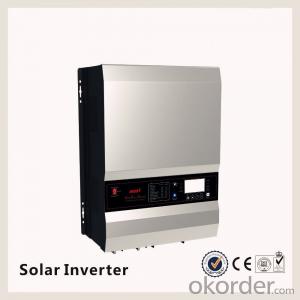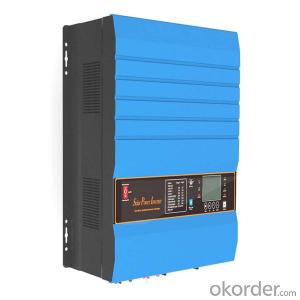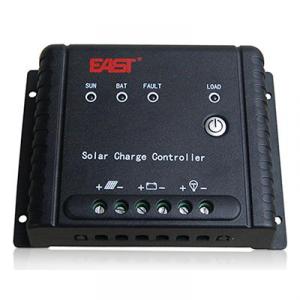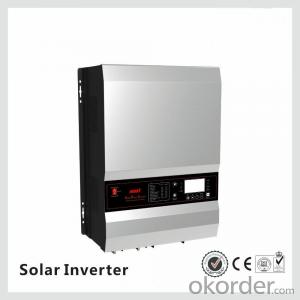Pv3500 Solar Inverter PV35-9K Low Frequency DC to AC Solar Power Inverter 12KW
- Loading Port:
- Shanghai
- Payment Terms:
- TT OR LC
- Min Order Qty:
- 1000 watt
- Supply Capability:
- 100000 watt/month
OKorder Service Pledge
OKorder Financial Service
You Might Also Like
Product Description
What is Solar inverter?
Solar pv inverters is an electronic system that operates the photovoltaic(PV) modules in a manner that allows the modules to produce all the power they are capable of. The solar mate charge controller is a microprocessor-based system designed to implement the MPPT. It can increase charge current up to 30% or more compared to traditional charge controllers.
Features
· Power range 1KW - 12KW
· Inbuilt pure copper transformer
· Powerful charge rate up to 100Amp
· MPPT solar charge controller 45A 60A (120A Option)
· PV input:145V max
· 12V/24V/36V/48V auto work
· MPPT efficiency>99% , Peak conversion efficiency>98%
· DSP processors architecture ensure high speed and performance
· Four-stages charging mode
· Protection: PV array short circuit, PV reverse polarity, Battery reverse polarity, Over charging, Output short circuit
· High efficency design & "Power Saving Mode" to coverse energy
Specification
MODEL | PV35-1K | PV35-2K | PV35-3K | PV35-4K | |||||||||||||||
Default Battery System Voltage | 12VDC | 24VDC | 12VDC | 24VDC | 12VDC | 24VDC | 12VDC | 24VDC | |||||||||||
INVERTER OUTPUT | Rated Power | 1KW | 2KW | 3000VA/2.4KW | 4000VA/3.2KW | ||||||||||||||
Surge Rating (20ms) | 3KW | 6KW | 9KW | 12KW | |||||||||||||||
Capable Of Starting Electric Motor | 1HP | 1HP | 1.5HP | 2HP | |||||||||||||||
Waveform | Pure sine wave/ same as input (bypass mode) | ||||||||||||||||||
Nominal Output Voltage RMS | 100V/110V/120VAC 220V/230V/240VAC(+/-10% RMS) | ||||||||||||||||||
Output Frequency | 50Hz/60Hz +/-0.3 Hz | ||||||||||||||||||
Inverter Efficiency(Peak) | >88% | ||||||||||||||||||
Line Mode Efficiency | >95% | ||||||||||||||||||
Power Factor | 0.8 | ||||||||||||||||||
Typical Transfer Time | 10ms(max) | ||||||||||||||||||
AC INPUT | Voltage | 230VAC | |||||||||||||||||
Selectable Voltage Range | 96~132VAC/155~280VAC(For Personal Computers) | ||||||||||||||||||
Frequency Range | 50Hz/60Hz (Auto sensing) 40-80Hz | ||||||||||||||||||
BATTERY | Minimum Start Voltage | 10.0VDC /10.5VDC for12VDC mode (*2 for 24VDC, *4 for 48VDC) | |||||||||||||||||
Low Battery Alarm | 10.5VDC+/-0.3V for12VDC mode (*2 for 24VDC, *4 for 48VDC) | ||||||||||||||||||
Low Battery Cutoff | 10.0VDC+/-0.3V for12VDC mode (*2 for 24VDC, *4 for 48VDC) | ||||||||||||||||||
High Voltage Alarm | 16.0VDC+/-0.3V for12VDC mode (*2 for 24VDC, *4 for 48VDC) | ||||||||||||||||||
High Battery Voltage Recover | 15.5VDC+/-0.3V for12VDC mode (*2 for 24VDC, *4 for 48VDC) | ||||||||||||||||||
Idle Consumption-Search Mode | <25W when power saver on | ||||||||||||||||||
CHARGER | Output Voltage | Depends on battery type | |||||||||||||||||
Charger AC Input Breaker Rating | 10A | 30A | 30A | 30A | |||||||||||||||
Overcharge Protection S.D. | 15.7VDC for 12VDC mode (*2 for 24VDC, *4 for 48VDC) | ||||||||||||||||||
Maximum Charge Current | 45A | 25A | 70A 35A | 90A 50A | 65A 40A | ||||||||||||||
BTS | Continuous Output Power | Yes Variances in charging voltage & S.D. voltage base on the battery temperature | |||||||||||||||||
BYPASS & PROTECTION | Input Voltage Waveform | Sine wave (grid or generator) | |||||||||||||||||
Nominal Input Frequency | 50Hz or 60Hz | ||||||||||||||||||
Overload Protection (SMPS Load) | Circuit breaker | ||||||||||||||||||
Output Short Circuit Protection | Circuit breaker | ||||||||||||||||||
Bypass Breaker Rating | 10A | 15A | 20A | 40A | |||||||||||||||
Max Bypass Current | 30Amp | ||||||||||||||||||
SOLAR CHARGER | Maximum PV Charge Current | 45A | |||||||||||||||||
DC Voltage | 12V/24V atuo work | ||||||||||||||||||
Maximum PV Array Power | 600W | 1200W | 600W | 1200W | 600W | 1200W | 600W | 3200W | |||||||||||
MPPT Range @ Operating Voltage(VDC) | 16-100VDC for 12V mode,32-100V for 24V mode | ||||||||||||||||||
Maximum PV Array Open Circuit Voltage | 100VDC | 147VDC | |||||||||||||||||
Maximum Efficiency | >98% | ||||||||||||||||||
Standby Power Consumption | <2w< span=""> | ||||||||||||||||||
MECHANICAL SPECIFICATIONS | Mounting | Wall mount | |||||||||||||||||
Dimensions (W*H*D) | 493*311*215mm | ||||||||||||||||||
Net Weight (Solar CHG) kg | 23.5 | 24.5 | 25.5 | 29.5 | |||||||||||||||
Shipping Dimensions(W*H*D) | 580*400*325mm | ||||||||||||||||||
Shipping Weight (Solar CHG) kg | 25.5 | 26.5 | 27.5 | 31.5 | |||||||||||||||
OTHER | Operation Temperature Range | 0°C to 40°C | |||||||||||||||||
Storage Temperature | -15°C to 60°C | ||||||||||||||||||
Audible Noise | 60dB MAX | ||||||||||||||||||
Display | LED+LCD | ||||||||||||||||||
Loading(20GP/40GP/40HQ) | 150pcs/300pcs/350pcs | ||||||||||||||||||
Images
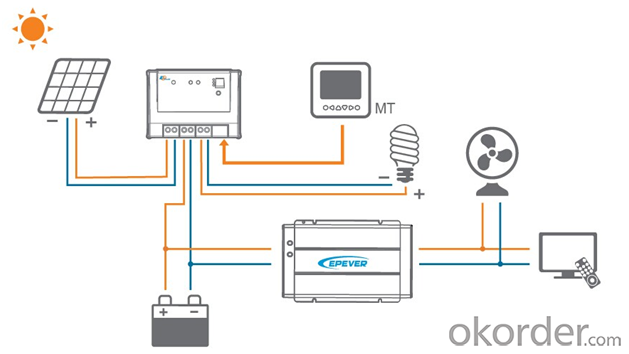
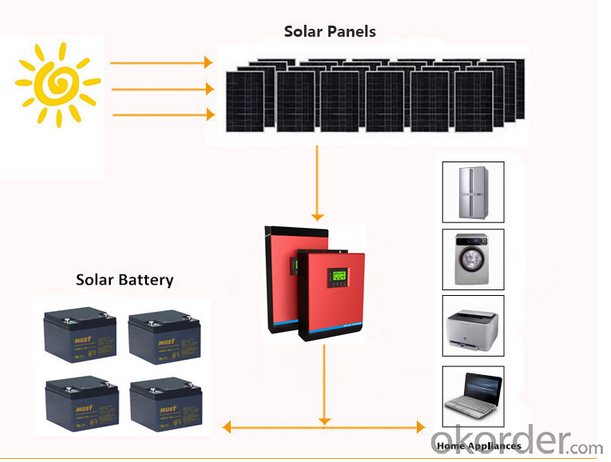
Packaging & Shipping
What is the packing?
1.Package: Carton Box for packaging, or Wooden Box advised for Samples to protect in transportations. Package designed by Clients is welcomed.
2.Shipping: DHL,FEDEX,UPS,EMS,AirWay and By Sea.
3.Payment: T/T( telegraphic transfer (T/T) and Western Union
4.Welcome to your Sample Order to test First.
FAQ
Q1: How to choose a right inverter?
A1:Tell us your demand, then our sales will recommend a suitable inverter to you.
Q2: What's the different between inverter and solar inverter?
A2: Inverter is only accept AC input, but solar inverter not only accept AC input but also can connect with solar panel to accept PV input, it more save power.
Q3: How about the delivery time?
A3: 7 days for sample; 25 days for bulk order.
- Q: What is the role of a display or user interface in a solar inverter?
- The role of a display or user interface in a solar inverter is to provide users with real-time information about the performance, status, and operational parameters of the inverter system. It allows users to monitor the energy production, voltage levels, current flow, and any potential faults or errors. Additionally, the user interface enables users to configure and control various settings of the solar inverter, such as output power limits, grid synchronization, and system diagnostics.
- Q: How does a solar inverter handle voltage dips and swells?
- A solar inverter handles voltage dips and swells by utilizing various protective mechanisms. When there is a voltage dip, the inverter typically has a built-in low voltage ride-through capability, which allows it to continue operating even if the grid voltage temporarily drops. The inverter adjusts its power output to match the reduced voltage, ensuring a stable and reliable energy supply. In case of voltage swells, the solar inverter employs voltage regulation techniques to prevent excessive voltage from harming the system. It monitors the grid voltage and adjusts its own output accordingly, ensuring that the generated solar power is safely integrated with the grid. This regulation mechanism helps protect both the inverter and other connected devices from potential damage caused by high voltage levels. Overall, the solar inverter's ability to handle voltage dips and swells is crucial for maintaining the stability and efficiency of a solar power system, enabling it to seamlessly adapt to varying grid conditions and safeguarding the equipment involved.
- Q: What is the maximum input voltage for a solar inverter?
- The maximum input voltage for a solar inverter depends on the specific model and manufacturer. It can vary, but generally, solar inverters can handle input voltages ranging from 300 to 1000 volts.
- Q: What is the importance of voltage and frequency control in a solar inverter?
- The importance of voltage and frequency control in a solar inverter is crucial for maintaining the stability and reliability of the power output. By regulating the voltage and frequency levels, the inverter ensures that the electricity generated from the solar panels is in sync with the grid requirements. This control is necessary to prevent damage to electrical appliances and equipment, maintain grid stability, and enable seamless integration of solar energy into the existing power system.
- Q: What is the maximum power capacity of a solar inverter?
- The maximum power capacity of a solar inverter can vary depending on its specific model and design. However, typical residential solar inverters have a power capacity range of 1-10 kilowatts (kW), while commercial and industrial inverters can range from 10 kW to several megawatts (MW).
- Q: How do you maintain a solar inverter?
- To maintain a solar inverter, regular inspections and cleaning are essential. It is crucial to check for any signs of damage or loose connections, and make sure the inverter is properly ventilated to prevent overheating. Additionally, keeping the surrounding area clean and free from any debris or obstructions can help optimize its performance. It is recommended to follow the manufacturer's guidelines and consult with a professional for any specific maintenance requirements.
- Q: What is the difference between a grid-connected inverter and an off-grid inverter? What are the advantages of a hybrid inverter?
- Hybrid inverter is not a clear concept, but now both energy storage dual-grid inverter does have the ability to receive control system,
- Q: What is the maximum DC input voltage for a solar inverter?
- The maximum DC input voltage for a solar inverter typically depends on the specific model and manufacturer. However, in general, the maximum DC input voltage for a solar inverter can range from around 500 volts to 1000 volts or more. It is important to consult the manufacturer's specifications for the specific solar inverter being used to determine the exact maximum DC input voltage.
- Q: How does a solar inverter affect the value of a property?
- A solar inverter can positively impact the value of a property by enhancing its energy efficiency and reducing electricity costs. This renewable energy technology is attractive to potential buyers as it provides clean and sustainable power generation. Additionally, having a solar inverter installed can increase the overall appeal and marketability of a property, making it more desirable in today's environmentally conscious market.
- Q: Are there any safety considerations when installing a solar inverter?
- Yes, there are several safety considerations when installing a solar inverter. Firstly, it is important to ensure that the inverter is installed by a qualified professional who is familiar with local electrical codes and regulations. This helps to minimize the risk of electrical hazards and ensures a safe installation. Additionally, proper grounding and bonding should be implemented to protect against electrical shock and lightning strikes. Adequate ventilation and temperature management are also important to prevent overheating and potential fire hazards. Overall, following safety guidelines and employing professional installation services are crucial to ensure the safe and efficient operation of a solar inverter system.
Send your message to us
Pv3500 Solar Inverter PV35-9K Low Frequency DC to AC Solar Power Inverter 12KW
- Loading Port:
- Shanghai
- Payment Terms:
- TT OR LC
- Min Order Qty:
- 1000 watt
- Supply Capability:
- 100000 watt/month
OKorder Service Pledge
OKorder Financial Service
Similar products
Hot products
Hot Searches
Related keywords
